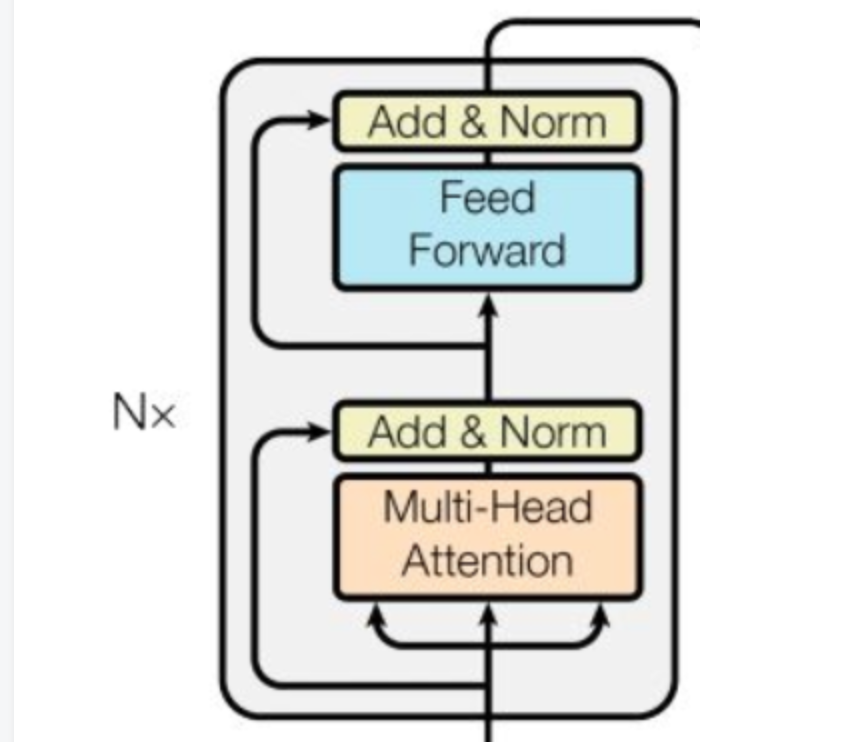参考网上博客阅读了bert的代码,记个笔记。代码是 bert_modeling.py
参考的博客地址:
https://blog.csdn.net/weixin_39470744/article/details/84401339
https://www.jianshu.com/p/2a3872148766
主要分为三部分:
1、输入数据处理,将词(中文的字)转换为对应的embeddging,增加positional embeddding 和token type embedding.
positional embedding 是词的位置信息,词在句子中的位置。token type embedding表示是哪个句子中的词。
输出的数据格式是[batch_size,seq_length;width], width是词向量的长度。
2、encoder部分主要是使用transformer对句子进行编码,transformer的主要结构是来自 attention is all you need,但是和论文中的结构有些小区别。
3、decoder部分主要是解码部分。
先介绍数据处理部分:
1、bert模型输入的文本处理之后封装为InputExample类,这个类包扩 guid,text_a,text_b,label
这些内容会被转换成一下的格式。##表示被mark的词,[CLS]起始第一个,在分类任务中表示句子的 sentence vector
[seq]表示句子的分隔符,如果只有一个句子text_b可以为空
tokens: [CLS] is this jack ##son ##ville ? [SEP] no it is not . [SEP]
# type_ids: 0 0 0 0 0 0 0 0 1 1 1 1 1 1
这里的输入句子会限定一个最大输入长度,不足的补0,这个0是指词对应的token_id。处理完成之后,将词的ID序列
转化为词向量的序列。
词ID序列到词向量序列的代码如下:
1 # Perform embedding lookup on the word ids. 2 (self.embedding_output, self.embedding_table) = embedding_lookup( 3 input_ids=input_ids, 4 vocab_size=config.vocab_size, 5 embedding_size=config.hidden_size, 6 initializer_range=config.initializer_range, 7 word_embedding_name="word_embeddings", 8 use_one_hot_embeddings=use_one_hot_embeddings)
下面代码在词向量序列上增加了 positional embeddings 和 token type embeddings。embedding_postprocessor 它包括token_type_embedding和position_embedding。也就是图中的Segement Embeddings和Position Embeddings。

##配置项 这部分代码注释写的非常详细,embedding_postprocessor的具体实现可以看源码的注释,Bert的position Embedding是作为参数学习得到的,
transformer的论文里是计算得到的。
1 self.embedding_output = embedding_postprocessor( 2 input_tensor=self.embedding_output, 3 use_token_type=True, 4 token_type_ids=token_type_ids, 5 token_type_vocab_size=config.type_vocab_size, 6 token_type_embedding_name="token_type_embeddings", 7 use_position_embeddings=True, 8 position_embedding_name="position_embeddings", 9 initializer_range=config.initializer_range, 10 max_position_embeddings=config.max_position_embeddings, 11 dropout_prob=config.hidden_dropout_prob)
特别说明一下,最后的输出增加了 norm和dropout output = layer_norm_and_dropout(output, dropout_prob)
2、Encoder部分代码
首先是对输入做了个attention_mask的处理
attention_mask = create_attention_mask_from_input_mask(input_ids, input_mask)
这个主要是减少对于mask的词和填充部分的词的关注。mask部分和填充部分在计算attention的时候分数自然应该很低才对。
然后是transformer_model,这部分主要是transformer,关于transformer可以参考 attention is all you need,这篇博客写的也不错,https://blog.csdn.net/yujianmin1990/article/details/85221271,这是翻译的一篇。
1 self.all_encoder_layers = transformer_model( 2 input_tensor=self.embedding_output, 3 attention_mask=attention_mask, 4 hidden_size=config.hidden_size, 5 num_hidden_layers=config.num_hidden_layers, 6 num_attention_heads=config.num_attention_heads, 7 intermediate_size=config.intermediate_size, 8 intermediate_act_fn=get_activation(config.hidden_act), 9 hidden_dropout_prob=config.hidden_dropout_prob, 10 attention_probs_dropout_prob=config.attention_probs_dropout_prob, 11 initializer_range=config.initializer_range, 12 do_return_all_layers=True)
接下来详细写写transformer_model的代码
函数定义如下:
1 def transformer_model(input_tensor, 2 attention_mask=None, 3 hidden_size=768, 4 num_hidden_layers=12, 5 num_attention_heads=12, 6 intermediate_size=3072, 7 intermediate_act_fn=gelu, 8 hidden_dropout_prob=0.1, 9 attention_probs_dropout_prob=0.1, 10 initializer_range=0.02, 11 do_return_all_layers=False):
input_tensor是[batch_size, seq_length, hidden_size]
attention_mask就是之前提过的用于处理padding部分和mask部分attention值的 形状[batch_size, seq_length,seq_length]
hidden_size这个是transformer的隐层的大小
num_hidden_layers:transformer有多少层,也就是blocks的数目。一个block的结构如下:
num_attention_heads: transformer中attention heads的个数,比如bert设置的是12,多头机制中head数。
intermediate_size:feed forward中间层的大小
接下来开始介绍代码,开始判断了一下hidden_size是否是num_attention_size的整数倍
对输入由三维改为二维,避免处理过程中多次tensor的变相,提高效率。
这一步将[batch_size,seq_len,width]改为[batch_size*seq_len,width]
prev_output = reshape_to_matrix(input_tensor)
接下来是 attention layer,这个是计算self-attention,当然如果 query和key一样的话,就是self-attention
首先第一步是计算query_layer,key_layer,value_layer。
这里把attention的计算抽象为 query,key和value三部分,通常key和value是一样的,然后根据query来计算不同的key 其value贡献的大小。
比如如果RNN这种seq2seq的话(encoder和decoder都是RNN),query是decoder前一时刻的输出,key和value是encoder RNN各个时刻的状态。
在计算时query_layer=W*query ,其他key value类似
1 # `query_layer` = [B*F, N*H] 2 query_layer = tf.layers.dense( 3 from_tensor_2d, 4 num_attention_heads * size_per_head, 5 activation=query_act, 6 name="query", 7 kernel_initializer=create_initializer(initializer_range)) 8 9 # `key_layer` = [B*T, N*H] 10 key_layer = tf.layers.dense( 11 to_tensor_2d, 12 num_attention_heads * size_per_head, 13 activation=key_act, 14 name="key", 15 kernel_initializer=create_initializer(initializer_range)) 16 # `value_layer` = [B*T, N*H] 17 value_layer = tf.layers.dense( 18 to_tensor_2d, 19 num_attention_heads * size_per_head, 20 activation=value_act, 21 name="value", 22 kernel_initializer=create_initializer(initializer_range))
然后是计算attention的分数,这个和transformer论文中的计算方式一致,
1 attention_scores = tf.matmul(query_layer, key_layer, transpose_b=True) 2 attention_scores = tf.multiply(attention_scores, 3 1.0 / math.sqrt(float(size_per_head)))
这部分代码中tensor的形状变化,和矩阵乘法的应用比较巧妙,可以推一下看看,代码写的很简洁。
这个部分是对attention mask的使用,如果是之前被mask和padding的部分,对应的分数设置为-10000,然后使用softmax计算分数
if attention_mask is not None: # `attention_mask` = [B, 1, F, T] attention_mask = tf.expand_dims(attention_mask, axis=[1]) # Since attention_mask is 1.0 for positions we want to attend and 0.0 for # masked positions, this operation will create a tensor which is 0.0 for # positions we want to attend and -10000.0 for masked positions. adder = (1.0 - tf.cast(attention_mask, tf.float32)) * -10000.0 # Since we are adding it to the raw scores before the softmax, this is # effectively the same as removing these entirely. attention_scores += adder # Normalize the attention scores to probabilities. # `attention_probs` = [B, N, F, T] attention_probs = tf.nn.softmax(attention_scores)
attention的分数这部分也有dropout
# This is actually dropping out entire tokens to attend to, which might
# seem a bit unusual, but is taken from the original Transformer paper.
attention_probs = dropout(attention_probs, attention_probs_dropout_prob)
接下来就是value_layer乘以attention_probs
attention_layer最后的输出是
[B*F, N*V]或者[B, F, N*V]
# Scalar dimensions referenced here:
# B = batch size (number of sequences)
# F = `from_tensor` sequence length
# T = `to_tensor` sequence length
# N = `num_attention_heads`
# H = `size_per_head`
对于多头机制,每个head都计算完attention_layer之后,将这些结果全都拼接起来。
attention_output = tf.concat(attention_heads, axis=-1)
注意这里attention_output最后一维的维度和layer_input一样的
attention_output = dropout(attention_output, hidden_dropout_prob)
attention_output = layer_norm(attention_output + layer_input)
这个是加上残差链接。
两个全连接层,最后加上dropout和 layer_norm
1 # The activation is only applied to the "intermediate" hidden layer. 2 with tf.variable_scope("intermediate"): 3 intermediate_output = tf.layers.dense( 4 attention_output, 5 intermediate_size, 6 activation=intermediate_act_fn, 7 kernel_initializer=create_initializer(initializer_range)) 8 9 # Down-project back to `hidden_size` then add the residual. 10 with tf.variable_scope("output"): 11 layer_output = tf.layers.dense( 12 intermediate_output, 13 hidden_size, 14 kernel_initializer=create_initializer(initializer_range)) 15 layer_output = dropout(layer_output, hidden_dropout_prob) 16 layer_output = layer_norm(layer_output + attention_output) 17 prev_output = layer_output 18 all_layer_outputs.append(layer_output)
